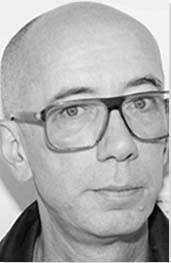Summary of Carsten Höller
Höller came to the fore of the contemporary art world in the 1990s as a key figure within the Relational Aesthetics movement. One of Germany's leading conceptual artists, he is recognized for interactive works that, like artists such as Phillippe Parreno, Pierre Huyghe, and Rirkrit Tiravanija, break down the divide between art, personal space, and sensory experience. Höller has produced playful installations incorporating steel-glass constructions, neon lighting rigs, giant rotating mushrooms, mirrors, and video screens. Other "ingredients" in his installations reflect his training as a biologist and have included animals and birds (some living; some replica). But Höller is undoubtedly best known for a series of interior and exterior winding tubular structures down which visitors of all ages are invited to temporarily abandon their inhibitions and "take the plunge".
Accomplishments
- Höller's work confronts the time-honoured customs of contemplative arts appreciation and exhibition. His art is focused rather on sensory experience, and as such, he brings a playful element to the world of contemporary art that often evokes - through devices such as helter-skelters, mirror halls, carousel rides - the joy of visiting a fun-fair rather than a "hallowed" art gallery.
- Höller's training as a biologist has been carried over into artworks that incorporate birds, insects, and animals. For him, animal life was perfect material for his art because it represents at once that unique mystery that exists in the space between the familiar and the unknown. Höller stated, "I'm fascinated by the impossibility of understanding the animal [...] they seem so close [and at] the same time they're so distant".
- As part of his interest in sensory experiences, Höller has explored the idea of hallucinogenics. In this respect, he has incorporated the motif of edible (agaric) mushrooms and fungi because they possess psychotropic properties. Works such as 2000's Upside Down Mushroom Room are not in fact so far removed from his slides given that both relate, directly or implicitly, to the temporary loss or distortion of cognitive control.
The Life of Carsten Höller
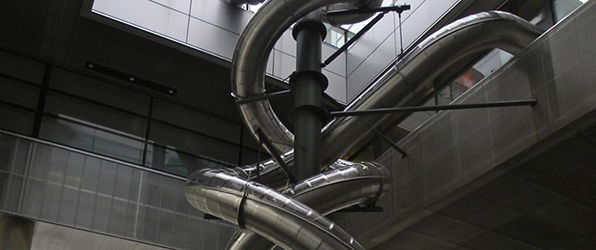
For Höller, slides are not just "a means of transportation, but also as a tool for introducing a moment of real madness into daily life". As he argued, "if slides were everywhere - if architects would listen to me and stop building only stairs, escalators, and elevators - it would be a different world".
Important Art by Carsten Höller
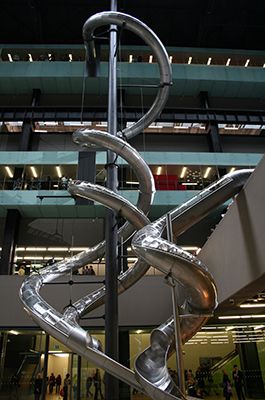
Test Site
Spectacle and play come together in Holler's monumental installation Test Site, made for Tate Modern's Turbine Hall in 2006. Five huge, spiral slides were designed to fill the hall, which visitors of all ages were invited to slide down. The slides encouraged participants to "flirt with danger" and to surrender to the exhilarating experience they bring about. Höller stated, "It's virtually impossible to go down a slide without smiling".
Slides have been a recurring theme in Höller's practice since 1998, but it was arguably this installation that first brought his art into the public's consciousness. The unusual title suggests each of the five slides needs to be tried out, or "tested" by gallery visitors. Höller says this is "to see how they are affected by them, to test what it really means to slide". He even suggests going down his slides can be a life-changing experience: "The state of mind that you enter when sliding, of simultaneous delight, madness and 'voluptuous panic' can't simply disappear without trace afterwards". Art critic Germano Celant concurred with the artists when he wrote, "In a slide you lose control; you cannot control your speed. It's hallucinatory". Celant likens this loss of control to the theme of uncertainty that is explored in other Höller works, "He is raising questions without answering them", he writes.
Installation - Tate Modern
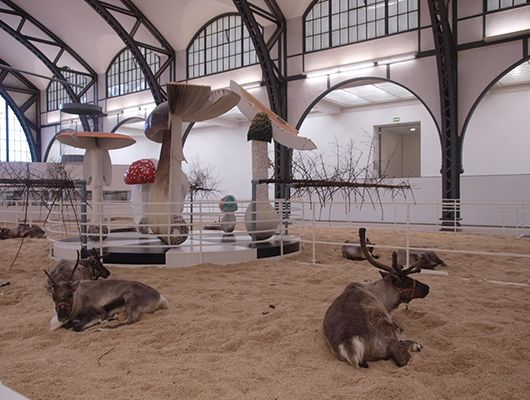
Soma
In his vast and complex installation Soma, Höller created a fantastical, psychedelic world filled with giant mushrooms, reindeer, canaries, mice, and flies. Installed in Hamburger Bahnhof, a former railway station in Berlin, this installation united multiple ideas that aim to induce a transformative experience for visitors to the site. In the center of this concoction was a giant floating bed, which gallery goers could pay to spend the night in.
The central theme of this installation explores the mythical drink known as Soma, referenced in ancient Hindu texts. Stories reveal this drink to have been consumed by mortals who were seeking transcendence and immortality. Now shrouded in mystery, historians and anthropologists have been searching in vain for the ingredients in Soma for centuries. Although nobody knows what went into the drink, it is thought it may have contained fly-agaric mushrooms, a poisonous, red-capped variety seen here in Holler's enlarged replica models. Scientific research has also revealed that if reindeer eat fly-agaric mushrooms, which they often do in the wild, their urine becomes even more hallucinogenic than the original drug.
Höller splits the arena in half. On one side, he suggests that the reindeer have been fed with hallucinogenic mushrooms, and their urine stored in a series of fridges. They are locked during the day, but are open for night-time visitors, who are invited to sample the urine for themselves to see if it might induce a mind-altering effect. Reindeer urine is also supposedly fed to the canaries, mice, and flies, who may or may not be undergoing a hallucinogenic experience.
In this myriad of ideas surrounding the mythical Soma drink, Höller asks viewers to fill in any questions and gaps with their imagination, inviting a series of divergent conclusions and interpretations. Art Critic Germano Celant notes how Höller is one of a generation of artists who use their art to seek out questions rather than answers, and to actively embrace a state of uncertainty. Likening Höller to artists such as Douglas Gordon, Damien Hirst and Maurizio Cattelan, Celant writes, "My generation was trying to create a utopia; this generation is asking questions only. Holler is a humorist but he has a serious desire to make people doubt everything".
Installation - Hamburger Bahnhof, Museum für Gegenwart - Berlin
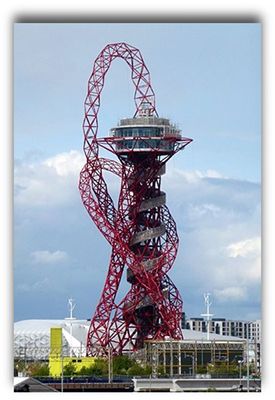
ArcelorMittal Orbit
The ArcelorMittal Orbit is the UK's tallest sculpture and was designed by Anish Kapoor as a new landmark to celebrate London's 2012 Olympics. Made from 600 prefabricated star-like nodes, the structure contains a staircase, elevators, an interior viewing platform and, from 2016, Höller's enormous helter-skelter slide. The slide encourages visitors/participants to ask themselves questions about how they occupy and move through space. Beginning in darkness beneath a huge domed steel canopy, the visitor travels up via the lifts towards the light at the top of the structure where they are met by two huge concave mirrors, designed by Kapoor, bringing the sky in as if in the lens room of a telescope. The visitor is then returned to earth in just 40 seconds via Höller's helter-skelter that snakes its way through Kapoor's iconic steel sculpture.
In an interview with arts journalist, Derek Blasberg, Höller explained that, as far as he and Kapoor were concerned, the sculpture should not be viewed as a collaborative work. He explained: "What's interesting for me, though, is that this is not a real collaboration. He [Kapoor] did his part, which was to build the tower and then I did my part, which was to build the slide connected to it. It's more about putting two things together, like a three-dimensional collage. This is intertwining ideas: we use the word 'grafting,' which is a better word than collaboration. The slide is a new element that is both symbiotic and parasitic to the tower. It's not fusing two artworks together, it's about one holding the other, like a skeleton holds the body's intestines in place".
The Queen Elizabeth Country Park perhaps sums up best the experience in its own publicity: "London's most exciting attraction, The Slide at the ArcelorMittal Orbit opened in June 2016 and visitors have been snapping up tickets to experience the truly hair-raising experience! Measuring 178m, The Slide is the world's tallest and longest tunnel slide. You will travel down the UK's tallest public artwork through light and dark sections as London's dramatic skyscape passes by. The Slide twists and turns 12 times, including a tight corkscrew section named the 'bettfeder' - after the German word for 'bedspring.' The Slide ends with a 50 metre straight run to the ground. In the exhilarating 40-second trip, riders are expected to hit speeds of up to 15 miles per hour!"
Steel and glass structure - Queen Elizabeth Olympic Park, Stratford, London
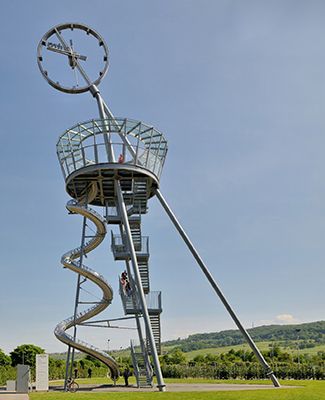
Vitra Slide Tower
Vitra Slide Tower is a multi-layered artwork woven with a series of complex meanings. Part viewing tower, part slide, and part revolving clock, this 30.7 metre tower has three diagonal columns meeting at the top. A criss-crossed staircase leads you up the tower to a viewing platform looking out across the Vitra Campus and its surrounding landscape, while also offering access to a twisted slide that corkscrews back down to ground level. Höller was commissioned to create this permanent, site-specific outdoor installation for the Vitra Campus in 2014, a furniture production company founded in 1950. He was selected by the furniture company because of the way his art could be, on one hand, entirely self-contained, yet also immersive and interactive, inviting lively audience participation. Höller engaged with the Vitra brand in his clock design; every twelve hours, the clock hands form the Vitra logo, but just for a few seconds.
In this work, and many of his other slide installations, Höller says the slide acts as both a sculptural motif and a form of physical entertainment. But he stresses that one doesn't have to use the slide to appreciate its impact. This idea is particularly pertinent in this artwork, which is designed to be seen from a distance by workers who spend time on the campus. Höller says, "it would be a mistake to think that you have to actually use the slide to make sense of it. Looking at the work from the outside is a different but equally valid experience, just as one might contemplate the endless column by Constantin Brancusi from 1938".
The leaning spiral form of this tower can be compared with Vladimir Tatlin's famous, unrealised Monument to the Third International (1920). But where Tatlin's tower was a utopian vision of modernity and industry, Höller's construction is, in essence, a far more playful and irreverent affair. Ralph Rugoff, director of London's Hayward Gallery, has noticed this cheeky playfulness in Höller's art, noting how, "He's super-sharp with a mind that just seems to be in a state of alert amusement".
Installation - Vitra Campus, Weil am Rhein, Germany
Two Flying Machines
Höller made his installation Flying Machine as part of the Hayward Gallery exhibition titled Decision in 2015. This awe-inducing installation encourages visitors to be strapped into a harness and spun around in circles over the gallery terraces and thereby taking in a birds-eye view across the city of London.
Much like his famous slide installations, this artwork mimes the experience of a daredevil fairground ride, but by ramping up its effects, Höller induces feelings of discomfort and fear. He ventures beyond mere entertainment with this installation and others like it, pushing gallery goers into extreme states of physiological transformation. He likens the states of mind his artworks induce to that of psychedelic drugs, which can instil the same disorientating and destabilising effect in the human mind. By lifting visitors off the ground and into the air, Höller allows them to see the world around them in an entirely new way, and to even transcend reality, if only for the duration of the ride. He calls this "letting go", a liberating experience that can be invigorating and life-affirming.
Installation - Hayward Gallery, London
Revolving Doors
This multi-panel installation encourages gallery visitors to walk through a complex labyrinth of moving mirrored panels, subverting and contorting the space around them. In the vein of other Höller works, this dizzying hall of mirrors destabilises the space around it, causing disorientating effects in the mind and body of the visitor. Höller takes the traditional "hall of mirrors" fairground concept, creating a gallery arena of shifting reflections and splintered views.
This work is one of a series made by Höller involving moving mirrored panels. They are arranged into mathematical structures, reviving Höller's training in scientific analysis, but the abstract effects they induce are at the opposite end of the scientific spectrum. Höller has said of such artworks, "My objects are tools or devices with a specific use, which is to create a moment of slight confusion or to induce hallucinations in the widest sense. That is why I call them 'confusion machines'". We might compare Höller's interactive mirrored installations with the art of American Minimalist Dan Graham, who makes structures from two-way mirrored panels that distort and fragment the viewer, merging them with their surrounding space something like a Cubist or Futurist painting. Höller's world is more extreme, however, pushing visitors into discomforting realms of doubt to emphasise the random and unexplainable nature of human existence.
Installation - Gagosian Gallery, New York
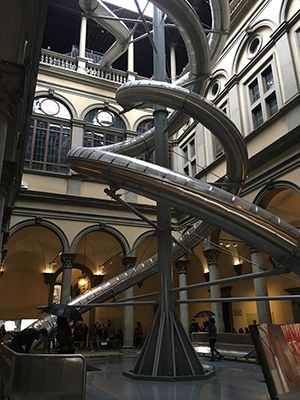
The Florence Experiment
The Florence Experiment was constructed by Höller for the Palazzo Strozzi in Florence, in 2018. Two monumental slides invited visitors to travel from the building's upper loggia to the courtyard below. In contrast with his earlier slide installations, which focussed on the individual's perceptual experiences, this artwork opened the field wider, looking at how plants might also be affected by being subjected to the exhilarating slide.
Höller created this slide in collaboration with the neurobiologist Stefano Mancuso. They shared their ideas in this installation with the goal of conducting an experiment on the differences (and similarities) between intelligent human and plant life. Once a week, visitors were invited to travel down the slides holding a bean plant which was then handed to a team of scientists who had installed a temporary laboratory on the courtyard level. The scientists analysed the bean plants, comparing them with those that had not been subjected to the slide experience, to see what (if any) changes had occurred.
By studying the plant's reactions to an external stimulus, Höller and Mancuso asked the audience to consider why we might see ourselves as superior beings to living forms without consciousness. Mancuso says, "we can ask ourselves whether man, with his special intelligence and his large brain that allows him to develop theories and to compose symphonies, sonnets and so on, is more or less 'fit' to survive than other species".
Installation - Palazzo Strozzi Firenze
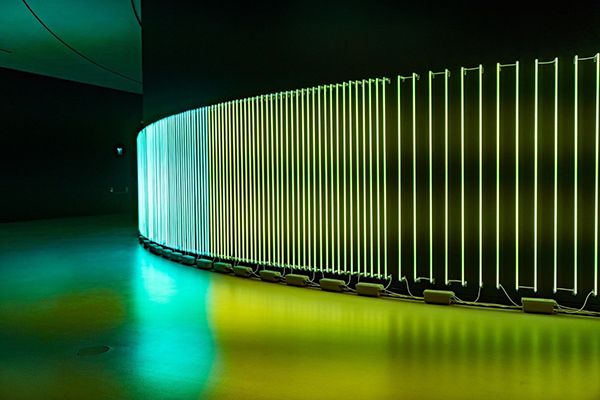
Divisions Wall
Divisions Wall is one of a series of light installations Höller brought together for an exhibition at Lisbon's Museum of Art, Architecture and Technology in 2021, titled DAY. Höller's intention for the entire exhibit was to disarm and disrupt the viewer's perceptions of time and space. Divisions Wall was made from neon tubes that follow the museum's architectural structure, gradually moving closer together as viewers follow its curving walls.
The exhibition brought together a series of light installations that Höller had been working on since the 1980s. But this was the first time all his light works had been seen together in one exhibition. In fact, the gallery was entirely lit by Holler's art, meaning walking through the installations became a journey through various light and dark scenarios that disorientated the human senses. While we might compare Höller's installations with the light art of Dan Flavin or James Turrell, Höller's, despite strong elements of mathematical formation and patterning, are more unstable and mystifying. This preoccupation with ideas of audience participation links Höller to other Relational Aesthetics artists such as Liam Gillick, who had also explored how his audience responds to his vividly colored grid-like installations. The final word went to Höller who stated "Individual experience is unpredictable, which maybe offers the entrance to a completely different experience of the world."
Installation - Museum of Art, Architecture and Technology (MAAT), Lisbon
Biography of Carsten Höller
Childhood
Carsten Höller was born in 1961 in Brussels. He remained in the Belgium capital throughout his childhood and adolescence. His parents were of German descent, and both worked for the European Economic Community. Drawn to science rather than art in his youth, Höller trained as a biologist, earning a doctorate (specializing in insects' olfactory communication strategies) in agricultural science from the University of Kiel in Germany in 1988. It was while running a research laboratory as an entomologist in Kiel that Höller first became interested in the arts; that interest ignited in fact by his domestic situation. He recalled, "There was an artists' bar in front of my apartment in Kiel, and I used to go there after work sometimes and have a beer, and I got to know some people, and they gave me some things to read. I was very hungry for everything about contemporary art. I read for a few years before I seriously started to do anything".
Early Training and Work
Höller began to have serious doubts about his future in science in the early 1990s. He recalls: "I could see how my life would continue if I stayed in science: become a professor, take over a faculty. I thought 'it's time to move on'". The idea of becoming an artist appealed to Höller because it could celebrate doubt and experimentation, qualities that are the very antithesis of scientific research. "Subjective personal experience in science is a no-no", he has said, "In starting to make art, I wanted to bring in what had been forbidden".
Although he moved away from scientific research, Höller's early art was still influenced by experiments related to biology and altered states of human consciousness. He was interested in art that could challenge and disrupt the viewer's way of experiencing the world. Many of Höller's earliest installations filled his viewers' minds with forebodings tinged with menace and threats of violence, such as the disturbing Killing Children "220 Volts" (1992), in which sweets are placed enticingly close to an exposed electricity cable. Höller explored his interest in drugs and psychedelic experiences in early artworks, too, including several giant-sized mushrooms that point to his ongoing interest in hallucinogenic fungi and the unpredictable experience they can invoke.
One of his most infamous pieces from this phase, Pealove Room (1993), comprised two sex harnesses and a phial of PEA, or phenylethylamine, an amphetamine-like chemical. Although it is unlikely any couples took up his open invitation to partake in both the drug inhalation and the sexual activity, Höller knew Pealove Room would elicit controversy. Indeed, in a 2013 interview for Purple magazine, art critic Oliver Zahm expressed surprise that Höller didn't "use sexuality more in [his] work" given that "sex offers access to a different state of mind". Höller answered: "Did you see the show at the New Museum [New York] about 1993? [...] I did a work where you could hang in the air and have sex after inhaling a specific kind of smell, which worked like a drug. [PEA] is quite effective when you smell it. It has to be very pure, and you have to inhale a lot. The effect is that you like other people more, in every way. Everything becomes sexualized [...] In the '90s you wouldn't be able to do this without risking some kind of reaction".
One of Höller's most successful earlier works was, Flugmaschine (Flying Machine) (1996), a large steel structure to which viewers/participants were strapped to a body harness and hoisted and spun through the air by an electric motor. Art critic Antony Hall has cited this piece as one of his first "quasi-scientific" experiments through which Höller "transform[ed] the gallery into a laboratory [often] disorientating the viewer, or more appropriately, the participant". Hall writes that "When asked if his work bridges art and science [Höller] claimed that he only uses the experimental form rather than simply introducing an experiment to the gallery [as in the "Action Lab" methodology for example]". (The idea of the Action Lab relates to the principle that participants learn about art as tool for personal empowerment. An Action Lab in Ossining, NY, for instance, speaks of five core principles: "gatherings, learning, experimentation, incubation, and fellowships".) For Höller however, his art is about "an experiment with oneself, without tangible results".
Mature Period
Art critic Elliat Albrecht writes, "Höller is perhaps best known for his enormous, tubular slides, the first of which were made for the 1998 Berlin Biennale. In the same year, Höller's carnival rides were exhibited at MASS MoCA [The Massachusetts Museum of Contemporary Art] in North Adams. Titled Amusement Park, the machines moved at dramatically slowed speeds and were kinetic sculptures rather than functioning rides. As in his slides, Höller embraced novelty and play while welcoming the viewer's bewilderment upon encountering carnivalesque 'entertainment' in a museum setting".
Moving into the late 1990's Höller became associated with a group of international conceptual artists, including Maurizio Cattelan, Douglas Gordon, Pierre Huyghe, Philippe Parreno, Rirkrit Tiravanija, and Andrea Zittel. He shared with them an emphasis on experiential installation art that breaks down the boundaries between real life and art. Höller's art became vaster and more ambitious, ranging from colossal slides to carousels, taxidermized animals and motorized beds, all aimed at immersing his viewer/participant in an entirely new realm of experience.
Like the other artists, Höller became linked to the French curator Nicolas Bourriaud's theory of Relational Aesthetics, a term he coined in 1996. Bourriaud's idea was that the artwork would reside in a temporary environment in which viewers could participate in an "art event". Bourriaud's belief was that interactivity and experience were more important than the material content of the artwork. It is easy to see how Höller, whose art focuses on human exchange rather than artefact or object-based art, and who even stated, "I don't believe in the art object", would be grouped with such like-minded artists. But he himself prefers not to have his work pigeon-holed in this way. As he said, "I don't like to be called an artist who does participatory work or is from the relational aesthetics generation. Even though I studied agriculture and specialized in pest control and the ways insects communicate, I don't like to be defined as a scientist making art either. I'm more of a mad professor".
Around this time, he married Swedish conceptual photographer Miriam Bäckström. Since the couple became parents to a daughter and a son, Höller's practice has gravitated further towards the idea of child-like play and freedom. The most obvious concession to playtime came in his slide installations which began to appear in galleries and museums around the world. Höller described the descent down one of his slides as "an emotional state . . . somewhere between delight and madness".
In 2000 he produced a slide that connected fashion designer Miuccia Prada's office with the ground floor of Prada's Milan headquarters. At this time, he also produced one of his fungi sculptures; a massive whimsical piece that reached up to the ceiling for "Upside Down Mushroom Room" at the Fondazione Prada (also in Milan). He also made his Giant Psycho Tank during this period. Gregory Volk, critic for Art in America, said that Giant Psycho Tank "probably induces more anxiety for most visitors than the comparatively risky slide, because total nudity is strongly recommended. A big enclosed, semitranslucent tank contains salty water a few inches deep. You climb up some stairs, disrobe and shower, while keenly aware that you (or part of you, as in your lower legs) can be observed from outside as you stand behind a door which has an open space at its bottom. Naked, you lie down in the water and float, letting your mind wander as you are gently swirled about. While the experience is peaceful, you can't quite shake the unnerving feeling that you are doing something intimate in public, or even that you are the subject of some quasi-scientific experiment".
Late Period
Höller has stated "I really don't like the idea of having a brand" and to this end has used playful, and vaguely concealed, pseudonyms including "Baldo Hauser" who he describes as "an ideal writer who says the things I want to be said but don't really mean". Indeed, he published the press release for his 2004 show at New York's Casey Kaplan Gallery under Hauser's name. (He also had been known to use the name "Karsten Höller" - the "K" replacing the "C" - to mischievously infer a more complex and idealised mirror image of the real artist.)
In 2006, Höller erected what was to become perhaps his most widely recognised slide project. Test Site featured a set of five giant slides positioned in Tate Modern's vast Turbine Hall. In 2008 he worked in collaboration with fellow artists Angela Bulloch, Maurizio Cattelan, Liam Gillick, Dominique Gonzalez-Foerster, Douglas Gordon, Pierre Huyghe, Jorge Pardo, Philippe Parreno, and Rirkrit Tiravanija to again transform the austere gallery environment, this time in the Guggenheim Museum's "theanyspacewhatever" exhibition. Höller's contribution was called Revolving Hotel Room, an installation of large rotating glass disks that was an exhibition piece at during gallery hours, and became a fully operational hotel room that viewers could book into for the night.
The Guggenheim's Chief Curator Nancy Spector wrote: "Working independently and in various collaborative constellations [Höller and the other artists] eschewed the discrete aesthetic object in favor of the exhibition environment as a dynamic arena, ever expanding in its physical and temporal parameters [...] Using the museum as a platform for projects that reach beyond the visual arts, their work often commingles with disciplines such as architecture, design, and theater, engaging directly with the vicissitudes of everyday life to offer subtle moments of transformation [the] artists all employ markedly different aesthetic strategies [but which] are conceptually unified by a desire to shift the terms of artistic practice beyond mimetic representation, and in doing so engender a kind of activated spectatorship".
In Christmas 2009 long-time friends and colleagues Höller and the German video artist, Marcel Odenbach, finally, after 10 years of design and planning, moved into a split Brutalist home/retreat on the Ghanaian coast. Art and Design journalist, Alice Rawsthorn wrote at that time, "One of the things Odenbach and Höller share is a long-standing fascination with Africa. Some of Odenbach's relatives had lived in Congo (now the Democratic Republic of the Congo), and he grew up listening to stories about their life there [while] Höller spent his childhood in Brussels flanked by neighbors on both sides who had lived in Congo. He was intrigued by the African artifacts he saw in their homes and in the nearby Royal Museum for Central Africa. Both he and Odenbach had traveled throughout sub-Saharan Africa, and in 1999 they visited ¬Ghana together". Staying at Biriwa Beach, the friends struck "on this crazy idea" to buy a plot of land and build a house overlooking the sea.
In 2011 Höller produced another of his iconic slide installations, this time at the Zagreb Museum of Contemporary Art in Croatia. It was custom made for the museum, with two intertwined slides that bend snakelike through the interior of the building. That same year he became better known to American audiences when he staged a retrospective called the "Carsten Höller Experience" at New York's, New Museum. The exhibition, which included a new work, Animal Group (2011), an assemblage of life-sized animal replicas represented in psychedelic colors, was described in its publicity as "an invitation to re-imagine the way in which we move through the world and the relationships we build as [Höller] asks us to reconsider what we think we know about ourselves".
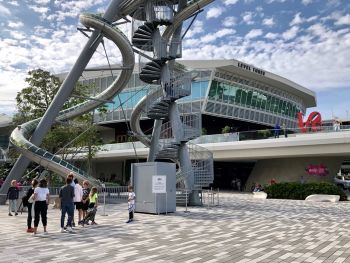
In 2014 Höller produced his Golden Mirror Carousel which was installed in an open-air sculpture court at the National Gallery of Victoria in Melbourne. Albrecht writes that the "spectacular carousel was a shining, gilded structure that also revolved at a slowed pace - approximately one rotation per five minutes. By extracting velocity from where it is expected, Höller asked viewers to contemplate the speed expected from both the entertainment industry and everyday life". But it is his slides that have come to define Höller's public perception. In 2016, for instance, he added a slide to the UK's tallest sculpture, the ArcelorMittal Orbit, originally designed by Anish Kapoor as a new national landmark to commemorate London's 2012 Olympics. The following year, he unveiled a nine-storey site-specific slide at the entrance to a Miami mall, the Aventura Slide Tower. It was his first permanent slide tower in the United States. More recently, Höller has returned to his career-spanning interest in artificial light and mood. His 2021 neon-light retrospective at Lisbon's Museum of Art, Architecture and Technology saw him at play with the affect that artificial light can have on the human senses.
Today, Höller lives and works in Stockholm with his wife and their two children. He and Backstrom have collaborated on projects and exhibitions together; this familial practice further emphasises Holler's desire to break down the boundaries between everyday life and art. Complementing his home life in Sweden, Höller ¬will "escape" to the sun during the ¬cruel Scandinavian winter. He states, "In Sweden, everybody has a summer house, but the summers in Stockholm are wonderful [...] I love the idea of doing it like the birds, migrating here [Ghana] for the winter. Coming to Ghana to see how the place works is always very fascinating [...] Unexpected things happen all the time; there is a lot of unpredictability. I feel very different when I am [in Ghana] and am able to look at my work from a different perspective".
The Legacy of Carsten Höller
Höller is considered one of the leading figures in the field of Relational Aesthetics (although he himself dislikes being placed within any one particular movement or trend), and as such, his practice has inspired other artists who emphasise experience over approbation of the conventional art object. These include Rafael Lozano-Hemmer, a Mexican-Canadian electronic artist whose work spans media aimed at interactivity such as robotic lights, digital fountains and computerized surveillance.
The psychedelic, hallucinatory element of Höller practice has also informed the practices of many artists who similarly aim to disrupt and distort conventional spaces and encourage viewers to adopt new ways of seeing. For instance, Austrian video artist Peter Kogler makes hypnotic, digitised wallpapers and digital screens that seem to warp and bend the space around them in a way that recreates the psychedelic experiences that Höller has explored.
The indefinable, or fluid, aspects of Höller's practice has also seen him linked to Nicolas Bourriaud's idea of "Altermodern", a term used to describe art which is made in response to our shifting borderless world. Bourriaud has written about, "cross-border, cross-cultural negotiations" and the idea of "a new real and virtual mobility" that celebrates "difference and singularity". Artists associated with the Altermodern include African artist Marthine Pascale Tayou, who makes hybrid sculptures and installations with detritus collected from his nomadic wanderings, and British artist Tris Vonna-Michell, who constructs multi-layered installations from found photographs, slides, and mementoes. These artists have taken forward the principle that art should be unpredictable and that ambiguity in art only adds to its power to engage its audience.
Influences and Connections

-
![Dan Graham]() Dan Graham
Dan Graham -
![Maurizio Cattelan]() Maurizio Cattelan
Maurizio Cattelan - Rosemarie Trockel
- Angela Bulloch
-
![Anish Kapoor]() Anish Kapoor
Anish Kapoor - Miriam Backstrom
- Marcel Odenbach
- Douglas Gordon
- Stefano Mancuso
-
![Dan Flavin]() Dan Flavin
Dan Flavin -
![James Turrell]() James Turrell
James Turrell ![Philippe Parreno]() Philippe Parreno
Philippe Parreno- Pierre Huyghe
- Rirkrit Tiravanija
-
![Anish Kapoor]() Anish Kapoor
Anish Kapoor - Miriam Backstrom
- Marcel Odenbach
- Douglas Gordon
- Stefano Mancuso
Useful Resources on Carsten Höller
- Carsten Höller: Soma. DokumenteOur PickBy Andrew McDonald
- Carsten Höller: Werkbeschreibungen des Künstlers und ausgewâhlte interviews
- Carsten Holler: DoubtBy Francesco Bonami
- Carsten Holler: DecisionBy Naomi Alderman
- Carsten Höller: Test Site (Unilever Series)By Jessica Morgan
- Carsten HollerOur PickBy Barbara-Brigitte Mak
- Carsten Holler: One Day One DayOur PickBy Jan Aman and Nathalie Erginot
- Carsten Holler: CarrouselBy Carl Roitmeister and Eckhard Schneider
- Carsten Höller: Artist's Portfolio (Cuaderno De Artista / Artist's Sketchbook)By Helle Crenzien, Detlev Gretenkort and Michael Juul Holm
- Carsten Holler - LebenBy Daniela Zyman
- Carsten HollerBy Germano Celant
- Carsten Holler (Suoercontemporanea)By Caroline Corbetta and Francesco Bonami
 Ask The Art Story AI
Ask The Art Story AI